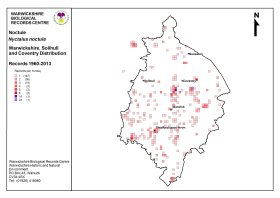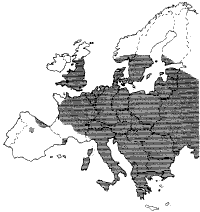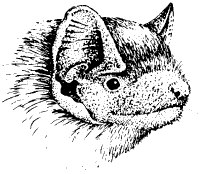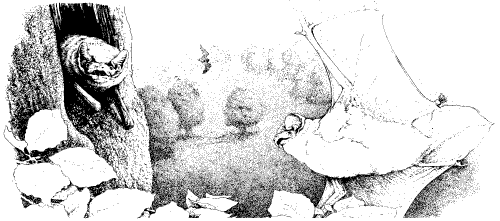Noctule

Distribution map for Noctule bats in Warwickshire. (Click for a full sized image)
The
Noctule bat (Nyctalus noctula) is one of the largest British
species and is usually the first bat to appear in the evening, sometimes
even before sunset. Adults generally have short, sleek, golden evenly coloured
fur. Juveniles, newly moulted adults and some females are a dull chocolate
brown colour. They have broad brown ears and a distinctive mushroom-shaped
tragus.
In
continental Europe the Noctule is a well known migrant but apart from
a few found in Orkney, Shetland and on North Sea oil rigs (well outside
the normal range) such movements have not been recorded in Britain. It
is still a relatively common species in much of England, Wales and up
to the south west of Scotland, but has become scarce in some areas of
intensive agriculture. The Noctule is absent from Ireland. It is common
throughout much of Europe but scarce in the south west (southern France,
Iberia).
 The Noctule bat has declined in Britain due to modern agricultural practices
resulting in the loss of suitable feeding habitats (such as permanent
pasture and woodland edge/hedgerows rich in invertebrate fauna). The heavy
management and loss of suitable trees for roosting may also have contributed
to this decline.
The Noctule bat has declined in Britain due to modern agricultural practices
resulting in the loss of suitable feeding habitats (such as permanent
pasture and woodland edge/hedgerows rich in invertebrate fauna). The heavy
management and loss of suitable trees for roosting may also have contributed
to this decline.
flight & ultrasound
Noctules have a characteristic powerful, straight flight on narrow pointed
wings. They fly in the open, often well above tree top level with repeated
steep dives when chasing insects. Noctule bats can fly at 50 kph (30mph).

Most food is caught on the wing and eaten in flight but occasionally
prey is taken from the ground and in suburban areas. Noctules are attracted
to street lamps to feed on moths. During spring Noctules will feed mainly
on smaller insects such as midges, changing their diet to take beetles
and moths later in the season. They forage mainly at dusk for up to 2
hours and for about half an hour at dawn.
Noctule ultrasound can be heard by some adults and children. The calls
range from 20 - 45 kHz and the best frequency to listen at is around 20
kHz. On a heterodyne bat detector a characteristic
'chip chop' with occasional clicks can be heard when feeding. However,
in a cluttered environment they may drop the first part of their 2-part
call. Their call is very loud with a slow and irregular repetition rate.
Noctule calls can be confused with those of the Serotine
or Leisler's:
Serotines do not make the chip-chop 2-part call but just a "chop"
that is loudest at about 27 kHz. If a "chip-chop" sound is heard
with a heterodyne detector set to 25 kHz Serotines can be discounted.
Also, Serotines are found more frequently at the edges of landscape features
such as tree lines or hedgerows whereas Noctules prefer a very open environment.
Leisler's has a loud call that is similar to the Noctule ("chip-chop")
but with many more "chips" than "chops". The Leisler's
"chop" is normally heard best above 20 kHz (at around 25 kHz)
as opposed to the Noctule's "chop" which is generally heard
best below 20 kHz.
 Noctule recorded on a Heterodyne bat detector
Noctule recorded on a Heterodyne bat detector
 Noctule recorded on a Time Expansion bat detector
Noctule recorded on a Time Expansion bat detector
breeding
 During
the summer male Noctules are solitary or form small bachelor groups. A
single male establishes a mating roost during late summer, usually in
a tree hole, for several weeks and defends his roost against other sexually
mature males. He emits a series of shrill mating calls from the roost
entrance or during flight and produces a strong odour, attracting a harem
of 4 or 5, but sometimes up to 20, females which stay with him for 1 or
2 days.
During
the summer male Noctules are solitary or form small bachelor groups. A
single male establishes a mating roost during late summer, usually in
a tree hole, for several weeks and defends his roost against other sexually
mature males. He emits a series of shrill mating calls from the roost
entrance or during flight and produces a strong odour, attracting a harem
of 4 or 5, but sometimes up to 20, females which stay with him for 1 or
2 days.
In April Noctule bats begin to form mixed sex colonies and can be found
in tree holes, buildings and bat boxes. Such colonies often break up in
late spring and smaller maternity colonies are found in trees, rarely
in buildings and bridges. The young are born in late June and July. Females
usually have one young but twins are regularly recorded. For 3 to 4 weeks
the young are suckled solely on their mother's milk and are fully weaned
and able to forage for themselves within 6 weeks.
The maternity colonies frequently change roost, mothers carrying the
smaller young between roosts during lactation. The young are left in crèches
while the mothers go off to feed.
Some females become sexually mature in their first autumn but many do
not mate until their second year. Males participate in mating from the
end of their first year.
summer roosts
 Noctule
bats are primarily tree dwellers and live mainly in rot holes and woodpecker
holes. They occur rarely in buildings but will use a wide variety including
modern houses. Within buildings they roost in gaps in large ridge tiles,
behind hanging tiles, between the ceiling and floor boarding, above large
soffits, between the tiles and ceiling of a converted attic. Sometimes
they roost in the lining of tall disused industrial chimneys and other
hollow walls including cavities in bridges.
Noctule
bats are primarily tree dwellers and live mainly in rot holes and woodpecker
holes. They occur rarely in buildings but will use a wide variety including
modern houses. Within buildings they roost in gaps in large ridge tiles,
behind hanging tiles, between the ceiling and floor boarding, above large
soffits, between the tiles and ceiling of a converted attic. Sometimes
they roost in the lining of tall disused industrial chimneys and other
hollow walls including cavities in bridges.
Most Noctule roosts in buildings are only gathering roosts, the colonies
moving off at the end of May and early June. The bats produce loud characteristic
metallic chirping sounds so that Noctule colonies can be heard up to 200
- 300 m away on hot days.
It seems that they are very selective about their tree hole roosts, preferring
large uncluttered woodpecker holes high up in trees in less dense areas
of woodland close to the woodland edge. Studies suggest that they move
roosts frequently so that the number of parasites that build up is kept
to a minimum; especially in juveniles.
winter roosts
Noctule bats hibernate mainly in trees or rock fissures and hollows,
but have also been found in bat boxes, buildings and other artificial
structures in winter. They sometimes form large mixed sex winter aggregations
of up to 1,000 bats in mainland Europe but the group sizes are smaller
in the UK.
Noctules have been observed feeding at any time in winter if conditions
are suitable but most can survive successfully without feeding for
nearly 4 months and can tolerate external temperatures as low as -16ºC.
| Description |
|
| Head and Body Length |
60 - 82 mm |
| Forearm Length |
48 - 58 mm |
| Wingspan |
320 - 400 mm |
| Weight |
18 - 40 g |
| Colour |
Adults golden brown, juveniles and some females dull
chocolate brown. |
|
|
| |
|
| Life Cycle |
|
| Mating Period |
August - October |
| Maternity Colonies |
Late spring.
Young: usually 1 born late June or July and weaned within 6 weeks. |
| Colony Size |
15 - 50 bats |
| Longevity |
Up to 12 years. |
| UK Status |
Vulnerable |
|
|
| |
|
| Habitat and Food |
|
| Summer Roosts |
Tree dwellers, occupying woodpecker holes and rot holes.
Seldom in buildings. |
| Winter Roosts |
Trees, rock fissures and hollows, bat boxes, buildings. |
| Feeding Habitat |
Over deciduous woodland, parkland, pasture, water and
at forest edges. |
| Food |
Moths, beetles ( mainly chafer and dung beetles), mayflies
and winged ants.

|